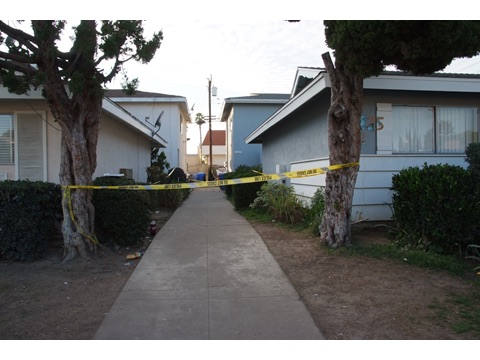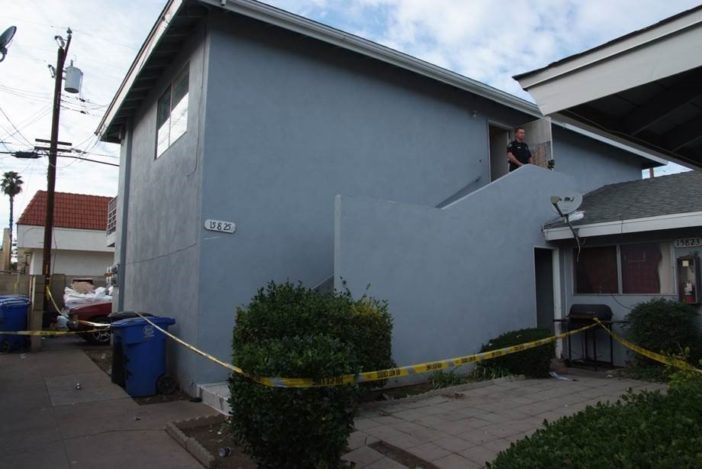“You have nothing on me. I’ll do a couple years in county, it will be a hung jury, then I’ll be out.”
The gang member known as Beaver was confident — cocky, even — as he predicted aloud to Tustin PD investigators how he believed his case would pan out.
The heavy-set Asian man with the skeleton hand tattooed from his fingertips to forearm sat relaxed in the jail cell.
He seemed almost too relaxed for a man just arrested on suspicion of murder.
Clouded by arrogance, Beaver would learn he grossly underestimated the Tustin Police Department.
The Gang Unit
Tough to investigate, and even tougher to prosecute is the way it goes for many gang cases.
“Today’s suspects are tomorrow’s victims,” said Tustin PD Sgt. Manny Arzate. “The guys we’re arresting for weapons, drugs, stealing a car, whatever it is, could be a victim then you have to go back and try and help them.”
“It’s a strange dynamic.”
And when these kinds of crimes happen, making headway on an investigation can be tricky.
Neighbors are often afraid to come forward to offer information, and anyone affiliated with a criminal street gang tends to stay tight-lipped.
But sometimes people talk and diligent hours of investigation pays off.
This held true for the Tustin PD Gang Unit when it recently saw the conviction of two gang members in the January 2010 murder of a local 16-year-old.
John Saway, 32, was convicted in May of first-degree murder with special circumstances of committing the crime for the benefit of a gang.
Saway’s co-defendant, Sarith Yin, 29, was convicted in January 2012 of murder, street terrorism and being a felon in possession of a firearm, with sentencing enhancements for being a documented gang member.
Saway’s conviction was the final page in a more than six-year legal process to prosecute those involved with the murder of Juan Carlos Rodriguez.
Murder on Myrtle
Arzate, case agent on the homicide, was one of four gang unit detectives who worked the Rodriguez case. Brian Stroud, who now works as a field training officer with Tustin PD, Nick Lopez, James Monsoor, and supervisor Sgt. Mike Lamoureux rounded out the team.
Hours of interviews, witness statements, evidence collected at the scene and court documents tell the narrative of this rare case in Tustin:
Rodriguez wasn’t a violent gang member, but the teen dabbled in some deviant and illegal behavior and was well-known to the Tustin PD gang unit. He hung around recently formed Tustin gang.
“He wasn’t someone who was beyond salvaging,” Arzate said. “He was young. He was a kid hanging out with the wrong crowd.”
This tagging crew was nothing like the gangs that lived across city borders in Santa Ana, where joining a gang can be a multi-generational tradition with a deep-rooted history of violence.
In Santa Ana, there is a long-founded rivalry between the Hispanic gangs and a faction of a Long Beach-based Cambodian group known as the Tiny Rascal Gang.
When a group of Cambodian gang members crossed paths with the mostly Hispanic Tustin crew on Jan. 10, 2010 things escalated quickly.
“The Cambodians took the rivalry they have in Santa Ana and brought it here,” Arzate said. “They shouldn’t have had a gang-related problem.”
Members of the Tiny Rascal Gang were walking to a nearby liquor store and exchanged heated, alcohol-infused words with the group of Hispanics from the newly formed gang out in the 15800 block of Myrtle.
“This is why it’s a classic gang case,” Arzate said, laying out how an argument ended in murder.
It started as a two-on-two challenge to a fight, then a four-on-two. Then a member of the Cambodian gang showed up with a kitchen knife.
The knife-wielding gang member realized he was surrounded by more than a dozen people from the Tustin crews, so both groups retreated. The Cambodians then called in for reinforcements.
“Just like in most gangs, (the Tiny Rascals) are not going to take being confronted and they don’t take an act of disrespect lightly,” Arzate said.
Saway and Sirith — serious Santa Ana gang members with We Don’t Care, an allied Cambodian gang — answered the call.
Meanwhile, the Tustin tagging crew retreated to the apartment where they had been partying and started breaking legs off tables and chairs to arm themselves.
They came outside and waited as Saway and Sirith came up on the apartment complex. The Cambodians flanked the area and opened fire.
Rodriguez ducked behind a bush with a teenage girl who had been hanging with the group, and would later serve as a key witness in Tustin PD’s case.
The girl urged Rodriguez to stay down and take cover, but Rodriguez fled down the narrow breezeway between two rows of apartments.
A bullet from Saway’s .45 caliber gun struck Rodriquez square in the back and exited through his chest.
Rodriguez’s friends dragged him into the nearby vacant apartment.
Tustin patrol officers responded to reports of shots fired. Shell casings scattered on the ground were the only sign something had happened.
There was nobody in sight, and no blood at the scene.
About an hour later, an anonymous caller reported an unresponsive teenager at one of the apartments near where the reported shooting occurred.
Police arrived and found Rodriguez. They tried to administer CPR, but it was too late.

John Saway, 32, was convicted in May of first-degree murder with special circumstances of committing the crime for the benefit of a gang.
Saway’s co-defendant, Sarith Yin, 29, was convicted in January 2012 of murder, street terrorism and being a felon in possession of a firearm, with sentencing enhancements for being a documented gang member.
Photo courtesy Tustin PD
Team effort
Now would come the strange, but expected, part: convincing the people you often chase for various crimes that you need their help to solve one.
“That was really difficult, as it is in most gang cases,” Arzate said. “They were having trouble trusting us.”
The members of the gang unit didn’t go home for days.
They took turns between interviews to grab broken hours of sleep on couches in the department, but the five-man unit wasn’t alone in poring over the case.
“All the units from the department came together,” Arzate said. “There is no way that one unit could have done it all.”
Help writing warrants, running surveillance and collecting evidence came from everyone available.
Arzate said he remembers some of Tustin PD’s police services officers on their hands and knees scouring the crime scene by the centimeter to ensure no evidence was missed.
Within a week, Tustin PD had arrested Saway and Yin on suspicion of murder, along with eight other suspects on various charges (many of which pleaded out or had reduced charges for their cooperation in building a case against the shooters).
“Everybody got involved and everybody contributed,” Arzate said.
The work paid off.
Saway will not be spending two years in county, as he forecast back in 2010. He instead could spend the rest of his life in state prison.
He was sentenced on May 13 to 25-years-to-life.
 Behind the Badge
Behind the Badge




